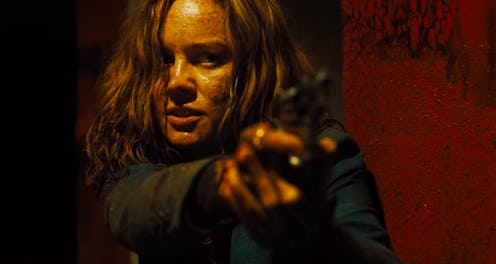
If you weren't desensitized to on screen gun violence before walking into the new movie Free Fire, you will be by the time you walk out. The film, featuring a huge ensemble cast led by Brie Larson, Cillian Murphy, Armie Hammer, and Sharlto Copley, is essentially a 90-minute shootout. There are only a handful of minutes in Free Fire that are gun-free; the majority of the movie's sequences would make Quentin Tarantino proud. Gun violence is the star of Free Fire, that's for sure — but contrary to what you might think, that doesn't necessarily mean the movie is pro-gun.
Hollywood has a complicated relationship with guns. The accusation that on screen gun violence inspires violence in real life (especially in America) has been lobbied at the industry for years, and it's no wonder why. According to a 2013 study by AA Publications, 94 percent of the biggest movies since 1985 feature at least one violent scene, half of which involve guns. Guns are everywhere in film, and the occurrences are increasing fast; the number of guns appearing on screen between 2010-2015 increased by 51 percent from a decade earlier, according to The Hollywood Reporter.
And in Free Fire, guns are everywhere. Ostensibly a movie about a gun deal gone bad, the film's plot is really just a long, messy shootout. Once the bullets start flying early on, it's every man for himself, and the gunfight quickly devolves into such a mess it's impossible to say who is on one side or the other. With such a thin plot, it's tempting to dismiss Free Fire as another example of Hollywood gun porn — a movie that glamorizes gun violence for no other reason than to entice and excite audiences. Yet while it's true that Free Fire clearly doesn't set out to be an anti-gun film, it's also not one that blindly endorses violence, either.
Free Fire isn't just a massive gunfight, but an absurd comedy of errors. Every gunshot fired is unnecessary, as the battle begins due to two impulsive men continuing a bar fight from the night before. A few characters manage to hold on to loyalty and morals, but in the end, each shot is fired by increasingly incompetent gunmen with thin motives and pathetic aim. Many times during the film, the fight seems so futile and insane that one can't help but wonder whether the movie is actually a sneaky anti-gun protest, meant to showcase the absurdity and pointlessness of gun violence.
The fighting in Free Fire is far from glamorous, and the film's 1978 setting helps the guns appear less realistic to modern audiences, thus keeping the film from feeling like one long gun commercial. Director and co-writer Ben Wheatley purposefully did not want the guns to be glossed over as another Hollywood set piece, making sure the first shots in the film were loud and alarming, like actual gunshots would be. "We wanted it to feel that it was scary and it was overwhelming," he said in an interview with The New York Times, noting that normal Hollywood procedure is to lessen the sound of guns in post-production.
When the first shots of the actual gunfight ring out in Free Fire, the sound is piercing, providing a stark contrast to the silent, slow motion shot of Stevo (Sam Riley) getting hit in the shoulder. Slow motion in action movies is usually glamorous, but in this film, it is used to show the ugliness of the shot and the ungraceful fall of the injured.
The gunfighting in Free Fire is remarkably unglamorous. It's chaotic, absent of the intricate fight choreography of Skyfall or Fate of the Furious, and does not have an exciting soundtrack or score to make the violence more fun. The lack of score in this first exchange emphasizes the noise of gunfire and immediately signals to the audience that Free Fire isn't here to fulfill action movie fantasies. In an interview with The Guardian, Wheatley said that part of his goal with Free Fire was to overwhelm the audience with the gun violence they came to see. "It's like saying: 'You like cake? How much cake can you eat? OK, have all the cake. And then look, here's some more.'"
Let's be real: the gun fight is Free Fire's main attraction — it is what will get audiences to buy tickets. By creating a non-stop shootout, Wheatley hopes audiences will be forced to confront their own desires for gun violence, telling Film Ink, "[Free Fire is going], 'you like violence. You're a genre fan, but you really [sic] like it. What is it that you like about it? And how do you feel about it when you're actually served it up?"
Wheatley may want audiences to question their obsession with on screen gun violence, but can a movie that's literally 90 minutes of gunfire really have an anti-gun message? Despite Wheatley's statements, watching Free Fire, one doesn't really get the feeling that the film is intended to provoke any real soul searching. At the heart of it, the movie intends to make a profit. It's a production just like any other, and it will depend on ticket sales for survival. That means that the film is inherently dependent on gun-loving audiences. The movie isn't marketed as a thoughtful meditation of gun violence, but as an action film full of gun fun. At the end of the day, it doesn't really matter if all the carnage in Free Fire has a point beyond gun porn, because that's what it's selling, both in trailers and in the movie itself.
Fans of on screen gun fights will leave Free Fire completely satisfied, but those looking for the movie to actually weigh in with an opinion on gun violence will leave the theater without an answer.